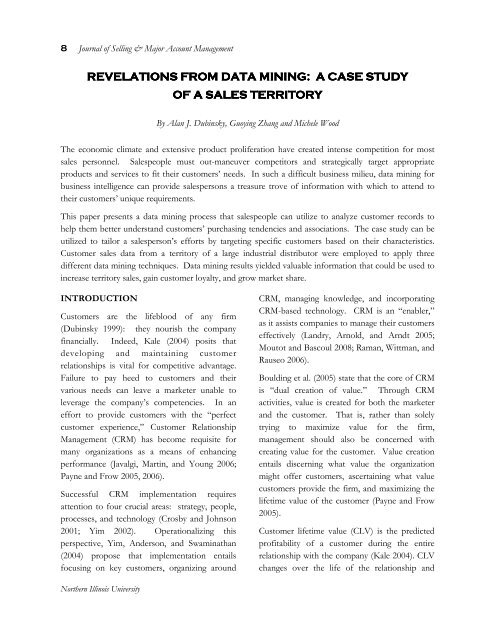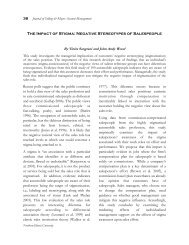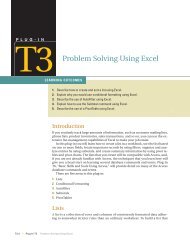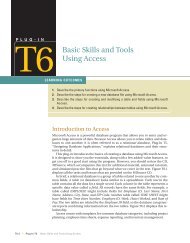revelations from data mining - NIU College of Business - Northern ...
revelations from data mining - NIU College of Business - Northern ...
revelations from data mining - NIU College of Business - Northern ...
Create successful ePaper yourself
Turn your PDF publications into a flip-book with our unique Google optimized e-Paper software.
8 Journal <strong>of</strong> Selling & Major Account Management<br />
REVELATIONS FROM DATA MINING: A CASE STUDY<br />
OF A SALES TERRITORY<br />
By Alan J. Dubinsky, Guoying Zhang and Michele Wood<br />
The economic climate and extensive product proliferation have created intense competition for most<br />
sales personnel. Salespeople must out-maneuver competitors and strategically target appropriate<br />
products and services to fit their customers’ needs. In such a difficult business milieu, <strong>data</strong> <strong>mining</strong> for<br />
business intelligence can provide salespersons a treasure trove <strong>of</strong> information with which to attend to<br />
their customers’ unique requirements.<br />
This paper presents a <strong>data</strong> <strong>mining</strong> process that salespeople can utilize to analyze customer records to<br />
help them better understand customers’ purchasing tendencies and associations. The case study can be<br />
utilized to tailor a salesperson’s efforts by targeting specific customers based on their characteristics.<br />
Customer sales <strong>data</strong> <strong>from</strong> a territory <strong>of</strong> a large industrial distributor were employed to apply three<br />
different <strong>data</strong> <strong>mining</strong> techniques. Data <strong>mining</strong> results yielded valuable information that could be used to<br />
increase territory sales, gain customer loyalty, and grow market share.<br />
INTRODUCTION<br />
Customers are the lifeblood <strong>of</strong> any firm<br />
(Dubinsky 1999): they nourish the company<br />
financially. Indeed, Kale (2004) posits that<br />
developing and maintaining customer<br />
relationships is vital for competitive advantage.<br />
Failure to pay heed to customers and their<br />
various needs can leave a marketer unable to<br />
leverage the company’s competencies. In an<br />
effort to provide customers with the “perfect<br />
customer experience,” Customer Relationship<br />
Management (CRM) has become requisite for<br />
many organizations as a means <strong>of</strong> enhancing<br />
performance (Javalgi, Martin, and Young 2006;<br />
Payne and Frow 2005, 2006).<br />
Successful CRM implementation requires<br />
attention to four crucial areas: strategy, people,<br />
processes, and technology (Crosby and Johnson<br />
2001; Yim 2002). Operationalizing this<br />
perspective, Yim, Anderson, and Swaminathan<br />
(2004) propose that implementation entails<br />
focusing on key customers, organizing around<br />
CRM, managing knowledge, and incorporating<br />
CRM-based technology. CRM is an “enabler,”<br />
as it assists companies to manage their customers<br />
effectively (Landry, Arnold, and Arndt 2005;<br />
Moutot and Bascoul 2008; Raman, Wittman, and<br />
Rauseo 2006).<br />
Boulding et al. (2005) state that the core <strong>of</strong> CRM<br />
is “dual creation <strong>of</strong> value.” Through CRM<br />
activities, value is created for both the marketer<br />
and the customer. That is, rather than solely<br />
trying to maximize value for the firm,<br />
management should also be concerned with<br />
creating value for the customer. Value creation<br />
entails discerning what value the organization<br />
might <strong>of</strong>fer customers, ascertaining what value<br />
customers provide the firm, and maximizing the<br />
lifetime value <strong>of</strong> the customer (Payne and Frow<br />
2005).<br />
Customer lifetime value (CLV) is the predicted<br />
pr<strong>of</strong>itability <strong>of</strong> a customer during the entire<br />
relationship with the company (Kale 2004). CLV<br />
changes over the life <strong>of</strong> the relationship and<br />
<strong>Northern</strong> Illinois University
Academic Article Spring 2010 9<br />
requires integration <strong>of</strong> the organization with the<br />
entire CRM process (Boulding et al. 2005). CRM<br />
efforts necessitate an ongoing balance between<br />
the customer and the firm as the relationship<br />
evolves through its stages (Reinartz, Krafft, and<br />
Hoyer 2004). Moreover, distribution <strong>of</strong> value<br />
across customers is uneven (Chen et al. 2006;<br />
Reinart, Krafft, and Hoyer 2004). Therefore,<br />
marketers must balance their customer portfolios<br />
vis-à-vis their customers’ needs, company efforts<br />
to foster customer value, and the means by<br />
which customers provide value for the firm<br />
(Boulding et al. 2005). Part <strong>of</strong> this entails<br />
correctly identifying responsive and pr<strong>of</strong>itable<br />
target customers (e.g., Cao and Gruca 2005).<br />
A key goal <strong>of</strong> CRM is to efficiently and<br />
effectively increase the acquisition and retention<br />
<strong>of</strong> customers by selectively building and<br />
maintaining mutually satisfying relationships with<br />
them. As Dickson et al. (2009, p. 113) aver:<br />
“When CRM is done right, it seamlessly<br />
integrates the marketing-sales-delivery-customerservice<br />
core functional added value<br />
processes….” Through advances in information<br />
technology, companies can realize improved<br />
customer relationships. CRM technology can<br />
foster gathering, analyzing, and interpreting<br />
various kinds <strong>of</strong> customer <strong>data</strong> in order to<br />
enhance the relationship with the customer. By<br />
converting customer information into usable<br />
<strong>data</strong>, CRM can increase the overall performance<br />
<strong>of</strong> a company (Yim, Anderson, and Swaminathan<br />
2004; Stein and Smith 2009).<br />
Use <strong>of</strong> information technology to manage<br />
customer relationships is a critical dimension <strong>of</strong><br />
relationship marketing (Anderson, Dubinsky,<br />
and Mehta 2007). In fact, it has been found to<br />
enhance salesperson performance (Hunter and<br />
Perreault 2007; Mathieu, Ahearne, and Taylor<br />
2007; Stoddard, Clopton, and Avila 2006) and<br />
other CRM outcomes (Moutot and Bascoul<br />
2008). Although diffusing technological<br />
innovation into a sales force may face resistance<br />
(Sharma and Sheth 2010), providing technology<br />
empowerment assists in salespeople’s<br />
technological usage (Chou, Pullins, and Senecal<br />
2007).<br />
A particularly beneficial technological tool for<br />
transforming customer information into usable<br />
<strong>data</strong>—and thereby assisting sales personnel to<br />
build sound relationships with customers—is<br />
<strong>data</strong> <strong>mining</strong>. Data <strong>mining</strong> refers to “all aspects<br />
<strong>of</strong> an automated or semi-automated process for<br />
extracting previously unknown or potentially<br />
useful knowledge and patterns <strong>from</strong> large<br />
<strong>data</strong>bases” (Olafsson, Li, and Wu 2008, p. 1429).<br />
Its main objective is to reveal interesting<br />
patterns, associations, rules, changes,<br />
irregularities, and general regularities <strong>from</strong> the<br />
<strong>data</strong> to improve decision making (Sumathi and<br />
Sivanandam 2006, p. 321).<br />
Data <strong>mining</strong> can help sellers (including sales<br />
personnel) enhance their understanding <strong>of</strong><br />
customers (Shaw et al. 2001, p. 128), as it entails<br />
“…searching and analyzing <strong>data</strong> in order to find<br />
implicit, but potentially useful, information…to<br />
uncover previously unknown patterns, and<br />
ultimately comprehensible information <strong>from</strong><br />
large <strong>data</strong>bases.” Furthermore, <strong>data</strong> <strong>mining</strong><br />
provides specific knowledge to organizations<br />
(e.g., salespeople) about each customer’s needs<br />
(Shaw et al. 2001). Moreover, it allows users to<br />
identify relationships between independent and<br />
dependent variables (Zhang et al. 2008). In<br />
addition, <strong>data</strong> <strong>mining</strong> approaches can reduce the<br />
effect <strong>of</strong> human bias on <strong>data</strong> analysis (Tu 2008).<br />
Data <strong>mining</strong> can reveal a treasure trove <strong>of</strong><br />
customer information and assist in a firm’s<br />
knowledge management process (Shaw et al.<br />
2001). This applies whether <strong>data</strong> <strong>mining</strong> is<br />
Vol. 10, No. 2
10 Journal <strong>of</strong> Selling & Major Account Management<br />
conducted at an aggregate company level or on<br />
an individual sales territory. Consequently, it can<br />
serve as an especially effective tool to help a<br />
salesperson attend to the unique needs <strong>of</strong> each<br />
<strong>of</strong> his or her customers. Moreover, it affords<br />
enhanced capability to deal with each customer.<br />
As Shaw et al. (2001, p. 128) assert:<br />
There is an increasing realization that<br />
effective customer relationship<br />
management can be done only based<br />
on a true understanding <strong>of</strong> the nees and<br />
preferences <strong>of</strong> customers…[d]ata<br />
<strong>mining</strong> tools can help uncover the<br />
hidden knowledge and understand<br />
customers better.<br />
Given the important role <strong>data</strong> <strong>mining</strong> can play in<br />
enhancing relationship marketing efforts,<br />
salespeople should be knowledgeable about how<br />
to perform <strong>data</strong> <strong>mining</strong>. They must pssess the<br />
technological tools and know-how to conduct<br />
<strong>data</strong> <strong>mining</strong> in a way that will allow them to<br />
leverage such efforts to advantage. Indeed,<br />
Anderson, Dubinsky, and Mehta (2007, p. 121)<br />
state that <strong>data</strong> <strong>mining</strong> is an especially useful tool<br />
for sales personnel, as it can “identify important<br />
relationships among buyers and the products<br />
they purchase, along with associated<br />
complementary products” and help salespeople<br />
assist their customers to sell effectively through<br />
their own accounts.<br />
The current paper presents a non-compex,<br />
useful approach to <strong>data</strong> <strong>mining</strong> that has bactually<br />
been utilized by a salesperson in an industrial<br />
setting. Discussed are three <strong>data</strong> <strong>mining</strong><br />
techniques, each with a unique focus that the<br />
host salesperson conducted with <strong>data</strong> <strong>from</strong> her<br />
accounts. The case study that follow is an<br />
attempt to show salespeople the value that their<br />
own use <strong>of</strong> <strong>data</strong> <strong>mining</strong> can <strong>of</strong>fer. As such, this<br />
paper partially answers a call by Raman,<br />
Wittmann, and Rausea (2006, p. 51) for “...future<br />
research [that] could focus on fine-grained<br />
aspects <strong>of</strong> CRM implementation and use.”<br />
DATA MINING ANALYSIS<br />
following stages: <strong>data</strong> preparation and<br />
exploration, <strong>data</strong> training and validation, model<br />
evaluation and selection, and application <strong>of</strong> the<br />
model on new <strong>data</strong> (Berson et al. 1999). In the<br />
stage <strong>of</strong> <strong>data</strong> training and validation, a number <strong>of</strong><br />
alternative methods exist. They can be<br />
categorized into the following four groups:<br />
clustering, classification, regression, and<br />
association rule learning (Fayyad, Piatetsky-<br />
Shapiro, and Smyth 1996). Shown in Table 1 are<br />
these four <strong>data</strong> <strong>mining</strong> techniques with their<br />
corresponding purposes.<br />
The objective <strong>of</strong> this paper is to illustrate a <strong>data</strong><br />
<strong>mining</strong> process that salespersons could use to<br />
develop a grow-sales strategy. This is done<br />
through exa<strong>mining</strong> relationships among various<br />
customer variables and sales information that are<br />
conceivably already in a firm’s <strong>data</strong> base. Using<br />
Table 1 as a guide, three <strong>data</strong> <strong>mining</strong> methods<br />
were employed in the present paper: multiple<br />
linear regression, association rules, and<br />
clustering. Regression analysis was used to<br />
develop models to predict annual sales revenue<br />
based on customer characteristics. Association<br />
rules were generated for the purpose <strong>of</strong> finding<br />
products that customers <strong>of</strong>ten purchase together;<br />
such information would be helpful for<br />
developing cross-selling strategies. Clustering<br />
was conducted to pr<strong>of</strong>ile customers and develop<br />
corresponding marketing strategies for different<br />
clusters (i.e., related groups <strong>of</strong> customers) 1 .<br />
The remainder <strong>of</strong> this paper will illustrate how an<br />
industrial salesperson undertook the three<br />
foregoing <strong>data</strong> <strong>mining</strong> techniques. Specific<br />
details <strong>of</strong> how the host salesperson conducted<br />
<strong>data</strong> <strong>mining</strong> will be described, thus providing<br />
user-friendly directions for sales personnel<br />
interested in utilizing <strong>data</strong> <strong>mining</strong> within their<br />
own territories.<br />
In general, the <strong>data</strong> <strong>mining</strong> process includes the<br />
<strong>Northern</strong> Illinois University
Academic Article Spring 2010 11<br />
Technique<br />
Clustering<br />
Classification<br />
Regression<br />
Table 1. Common Data Mining Methods<br />
Purpose<br />
Discovering groups and structures in the <strong>data</strong> that are in some way “similar.”<br />
Making classifications <strong>of</strong> new <strong>data</strong> with known classes. Common algorithms<br />
include decision tree, nearest neighbor, naive Bayesian, neural networks, and<br />
support vector machines.<br />
Estimating parameters in an assumed function form by fitting the <strong>data</strong> with<br />
the least error. The established function can be used to predict new <strong>data</strong>.<br />
Association Rule Searching for association relationships between variables. A common<br />
example is referred to as “market basket analysis” to determine products or<br />
services that will be purchased together.<br />
Data Collection<br />
Initially, salespeople must identify and collect the<br />
<strong>data</strong> that they feel is pertinent to their specific<br />
<strong>data</strong> <strong>mining</strong> situation. Sales personnel interested<br />
in <strong>data</strong> <strong>mining</strong> ideally should be able to obtain<br />
<strong>from</strong> company records the <strong>data</strong> utilized in this<br />
paper. Indeed, the host salesperson in this study<br />
requested the <strong>data</strong> <strong>from</strong> her management in<br />
order to undertake <strong>data</strong> <strong>mining</strong>. She focused<br />
solely on her own accounts and described the<br />
importance <strong>of</strong> <strong>data</strong> <strong>mining</strong> to management to<br />
justify her being given the <strong>data</strong>. When proposing<br />
to management the advantages <strong>of</strong> using <strong>data</strong><br />
<strong>mining</strong>, salespeople can make the following<br />
arguments:<br />
• Data <strong>mining</strong> can reveal an abundance <strong>of</strong><br />
customer information.<br />
• Data <strong>mining</strong> helps salespeople improve their<br />
understanding <strong>of</strong> customers.<br />
• It requires users to search and analyze <strong>data</strong><br />
to find useful information that can uncover<br />
previously unknown patterns <strong>of</strong> relationships<br />
among customer variables (e.g., sales volume<br />
and such factors as customer size, channel <strong>of</strong><br />
distribution, use <strong>of</strong> e-commerce).<br />
• Data <strong>mining</strong> can <strong>of</strong>fer detailed information<br />
about each customer’s needs.<br />
• It allows firms to make enhanced use <strong>of</strong> the<br />
information they have about their customers.<br />
• Data <strong>mining</strong> can serve as an especially<br />
effective tool to help salespeople attend to<br />
the unique needs <strong>of</strong> their customers.<br />
As such, the salesperson must first identify the<br />
relevant group <strong>of</strong> accounts on which he or she<br />
wishes to undertake <strong>data</strong> <strong>mining</strong>. The<br />
salesperson in our case study gathered <strong>data</strong> for a<br />
12-month period <strong>from</strong> an average-sized sales<br />
territory <strong>of</strong> Company DM (the real name <strong>of</strong> the<br />
company is not disclosed for confidentiality).<br />
DM is a Fortune 500 company and one <strong>of</strong> North<br />
America’s largest maintenance, repair, and<br />
operations (MRO) product distributors. It<br />
competes with other broad-line distributors,<br />
regional suppliers, and local suppliers. The host<br />
salesperson’s entire sales territory consists <strong>of</strong><br />
twenty customers in the commercial<br />
manufacturing and health care segments 2 . The<br />
average annual sales volume for the host<br />
salesperson’s customer <strong>data</strong> set was $103,487.56.<br />
The standard deviation was $23,497.83. The<br />
smallest customer generated annual sales <strong>of</strong><br />
$4,477.86 (a new health care customer), and the<br />
largest customer in the <strong>data</strong> set purchased<br />
products totaling $330,513.00 over the 12-month<br />
period.<br />
Data Preparation<br />
After the salesperson has identified the relevant<br />
Vol. 10, No. 2
12 Journal <strong>of</strong> Selling & Major Account Management<br />
Table 2: Product Category Spending by Selected Customers<br />
Customer LAMPS BALLASTS FIX-<br />
TURES<br />
PORTABLE<br />
LIGHTING<br />
FLASH-<br />
LIGHTS/<br />
ELECTRICAL<br />
SUPPLIES<br />
1 $86 $82<br />
2 $596 $6 $364 $2,700 $706<br />
3 $29 $344 $1,298<br />
4 $17,156 $61 $12,281 $489 $1,076 $44,541<br />
5 $141<br />
6 $5,190 $25 $1,904<br />
7 $5,252 $1,205 $13,611 $3,298 $3,416 $40,797<br />
8 $2,181 $276 $136 $2,275<br />
accounts for <strong>data</strong> <strong>mining</strong>, he or she should<br />
classify the <strong>data</strong> that will be used in the analyses.<br />
The classification could be at two levels—<br />
product grouping and customer pr<strong>of</strong>iles.<br />
Product Groupings In a multi-product firm,<br />
the salesperson would need to determine how<br />
the product mix can be meaningfully classified<br />
(e.g., product line, complementary items,<br />
individual items). With respect to product<br />
grouping in our case study, the host salesperson<br />
examined her product sales for each customer,<br />
ultimately categorizing the sales into the 102<br />
distinct DM product categories. Shown in Table<br />
2 is the annual spending on selected product<br />
categories for a portion <strong>of</strong> the host salesperson’s<br />
twenty customers during the 12-month period. 3<br />
Customer Pr<strong>of</strong>iles In addition to grouping<br />
products, the salesperson needs to identify<br />
germane characteristics that can be used to<br />
classify customers vis-à-vis the nature <strong>of</strong> their<br />
interactions with the firm. Doing so will<br />
produce a pr<strong>of</strong>ile for each customer.<br />
Prospective characteristics might include such<br />
features as customer size, customer<br />
demographics, purchase patterns, account call<br />
frequency, and so on. For each characteristic,<br />
the salesperson will assign a numerical value (e.g.,<br />
0, 1, 2) to represent the corresponding category<br />
<strong>of</strong> the characteristic.<br />
With respect to customer pr<strong>of</strong>iles in our case<br />
study, the host salesperson identified certain<br />
customer dimensions <strong>of</strong> her twenty customers<br />
that could meaningfully portray her accounts.<br />
Based on her knowledge <strong>of</strong> the territory and<br />
input <strong>from</strong> DM management, the following<br />
pr<strong>of</strong>ile characteristics <strong>of</strong> each customer, as<br />
portrayed in Table 3, were selected:<br />
1. Customer Segment Type: 0=Manufacturing,<br />
1=Health care.<br />
2. Corporate Account: 0=No, 1=Yes, (i.e.,<br />
whether the customer has corporate account<br />
status with DM’s corporate <strong>of</strong>fice).<br />
3. VMI: 0=No, 1=Yes. VMI refers to<br />
“vendor managed inventory.” This means<br />
that a DM employee goes to the customer<br />
location weekly with a bar code scanner to<br />
order products, place replenishment product<br />
<strong>Northern</strong> Illinois University
Academic Article Spring 2010 13<br />
onto customer shelves, and assist the<br />
customer with product selection for spot<br />
(unplanned/impulse) purchases.<br />
4. PPD (Pre-paid) Freight: 0=No, 1=Yes. DM<br />
pays the freight for customers whose<br />
purchase level reaches a particular threshold;<br />
some <strong>of</strong> DM’s corporate contracts receive<br />
this incentive.<br />
5. E-commerce Customer: 0=No, 1=Yes.<br />
This variable indicates whether the customer<br />
utilizes some kind <strong>of</strong> electronic means (e.g., e<br />
-mail, EDI) to conduct transactions with<br />
DM.<br />
6. Distance <strong>from</strong> DM Store: Total distance in<br />
miles <strong>from</strong> the closest DM store.<br />
7. Primary Order Method: Three different<br />
primary order methods were used, coded as<br />
follows: 00 = Phone, 01 = Fax, 10 = E-<br />
commerce.<br />
8. MRO Potential: Total annual dollars that<br />
the customer spends with all suppliers for<br />
maintenance, repair, and operating products.<br />
9. Number <strong>of</strong> Contacts: Total number <strong>of</strong><br />
individuals within the customer’s firm who<br />
order <strong>from</strong> DM.<br />
10. E-commerce Share: The percentage <strong>of</strong> the<br />
customer’s sales that are procured through<br />
electronic channels (i.e., EDI, DM.com,<br />
email, or some other type <strong>of</strong> electronic<br />
platform).<br />
11. Primary Discount: The minimum discount<br />
that the customer receives for any item<br />
purchased <strong>from</strong> the DM catalog.<br />
12. Count <strong>of</strong> Categories Purchased: The total<br />
number <strong>of</strong> distinct product categories <strong>from</strong><br />
which the customer purchased items.<br />
DATA ANALYSES<br />
At this juncture in the process, the salesperson<br />
now selects alternative <strong>data</strong> analytic techniques<br />
that he or she could use for <strong>data</strong> <strong>mining</strong>. The<br />
techniques ultimately used should be based on<br />
the purpose for undertaking the <strong>data</strong> <strong>mining</strong>. As<br />
noted earlier, shown in Table 1 are the four<br />
general <strong>data</strong> <strong>mining</strong> techniques and their<br />
corresponding purposes. In our cases study,<br />
multiple linear regression, cluster analysis, and<br />
association rules were the techniques selected.<br />
The host salesperson opted for these three<br />
techniques because her purposes for <strong>data</strong> <strong>mining</strong><br />
were to (a) employ a set <strong>of</strong> customer<br />
characteristics to predict sales revenue per<br />
customer (thus, multiple linear regression), (b)<br />
segment the territory into customer groups (thus,<br />
cluster analysis), and (c) identify cross-selling<br />
opportunities (thus, association rules). Each <strong>of</strong><br />
these techniques will now be described vis-à-vis<br />
salesperson <strong>data</strong> <strong>mining</strong>.<br />
Multiple Linear Regression.<br />
If a salesperson wishes to use multiple linear<br />
regression in <strong>data</strong> <strong>mining</strong>, most likely he or she<br />
will utilize it to forecast sales revenue per<br />
customer. Multiple linear regression is a<br />
prediction-type analysis where historical <strong>data</strong> are<br />
used to build a model that helps forecast a future<br />
event (i.e., sales in this study). Accordingly, the<br />
salesperson must identify a set <strong>of</strong> germane<br />
customer characteristics that are likely to be<br />
related to sales revenue. The customer pr<strong>of</strong>ile<br />
that the salesperson has already created (as noted<br />
above) should conceivably consist <strong>of</strong> those<br />
relevant customer characteristics.<br />
Once the requisite <strong>data</strong> have been obtained for<br />
use in multiple linear regression, the salesperson<br />
Vol. 10, No. 2
14 Journal <strong>of</strong> Selling & Major Account Management<br />
Table 3. Customer Characteristic Data<br />
Customer<br />
12-month<br />
Sales<br />
Customer<br />
Type<br />
Corporate<br />
Account<br />
VM<br />
I<br />
PPD<br />
Freight<br />
E-<br />
Commerce Distance<br />
Primary Order<br />
Method<br />
(e-commerce)<br />
Primary<br />
Order<br />
Method<br />
(Fax)<br />
MRO<br />
Potential<br />
Number<br />
<strong>of</strong> Contacts<br />
E-<br />
commerce<br />
Share<br />
Primary<br />
Discount<br />
1 $25,000.00 0 0 0 0 1 20 1 0 2000000 27 45.57 5<br />
2 $108,091.26 0 0 0 1 1 50 1 0 2000000 42 57.62 10<br />
3 $16,464.12 1 1 0 0 0 150 0 0 200000 14 1.15 10<br />
4 $330,513.00 0 1 1 1 0 65 0 1 800000 31 0 15<br />
5 $37,967.80 0 0 0 0 0 100 0 0 900000 11 0 5<br />
6 $43749.00 0 0 0 0 0 12 0 1 1300000 30 17.12 10<br />
7 $220,556.48 0 0 0 1 1 15 1 0 200000 82 35.86 10<br />
8 $34,781.97 1 1 0 1 1 75 1 0 300000 8 89.7 10<br />
9 $19,962.18 0 0 0 0 0 75 0 0 2000000 17 1.95 7.5<br />
10 $289,831.27 0 1 0 1 1 45 1 0 300000 32 10.23 10<br />
11 $46,821.18 1 1 0 1 1 7 1 0 80000 5 94.35 10<br />
12 $70,000.00 0 0 0 0 0 12 0 0 400000 13 0 10<br />
13 $51,417.57 0 0 0 0 0 20 0 0 700000 12 0 10<br />
14 $65,934.76 0 0 0 0 0 5 0 0 100000 8 1.11 10<br />
15 $4,477.86 1 1 0 0 1 75 0 0 40000 8 0 10<br />
16 $213,149.00 0 1 1 1 0 80 0 0 1400000 9 0.89 13<br />
17 $13.678.01 0 0 0 0 1 50 1 0 600000 17 43.21 5<br />
18 $192,790.40 0 1 1 1 1 1 0 0 700000 43 0 10<br />
19 $258,902.14 0 0 0 1 1 5 1 0 1100000 31 47.6 15<br />
20 $25,663.24 0 0 0 0 1 5 0 1 700000 15 30.09 5<br />
Note: Phone orders were coded as “00”. Therefore, if both columns for “Primary Order Method” (e-commerce and fax columns) contain a “0” for a particular customer, this<br />
means that the customer was using the phone as the primary order method.<br />
<strong>Northern</strong> Illinois University
Academic Article Spring 2010 15<br />
must select computer s<strong>of</strong>tware to conduct the<br />
analysis. An array <strong>of</strong> s<strong>of</strong>tware options is<br />
available on the market. Prototypical options<br />
include SAS (Statistical Analysis S<strong>of</strong>tware), SPSS<br />
(Statistical Programming for Social Science),<br />
STATA, and XLMiner for Excel. Each s<strong>of</strong>tware<br />
package provides essentially similar routines for<br />
multiple linear regression.<br />
A primary research question <strong>of</strong> our host<br />
salesperson was, “What factors (those noted in<br />
Table 3) determine the sales volume <strong>of</strong> a<br />
customer” For example, does giving the<br />
customer pre-paid freight increase sales Does<br />
deploying labor in the form <strong>of</strong> vendor managed<br />
inventory augment sales If the customer’s<br />
corporate <strong>of</strong>fice enforces the contract, might<br />
sales rise The host salesperson’s goal was to<br />
understand what DM programs and services, if<br />
any, may be used to forecast a customer’s annual<br />
sales. Therefore, the <strong>data</strong> set presented in Table<br />
3 was utilized for regression analysis. The<br />
resulting model could then be applied to develop<br />
and implement a sales plan directed at enhancing<br />
sales with other customers in the territory.<br />
Results <strong>from</strong> the regression analysis are<br />
presented in Table 4. The host salesperson<br />
utilized Excel to conduct the analysis owing to<br />
its widespread availability in Micros<strong>of</strong>t Office.<br />
The multiple R-square <strong>of</strong> 0.99 indicates that the<br />
regression model explains 99 percent <strong>of</strong> the<br />
variation in total sales dollars <strong>of</strong> the customers in<br />
the study. This means that the independent<br />
variables (customer pr<strong>of</strong>ile characteristics—<br />
Table 3) chosen for this regression analysis are<br />
helpful in explaining the variance in the<br />
dependent variable—annual sales. The<br />
significant independent variables—as evidenced<br />
by the statistically low p-value (less than 0.05)—<br />
are corporate account, pre-paid freight, primary<br />
order method/e-commerce, primary order<br />
method/fax, and E-commerce share. 4<br />
The regression model can be interpreted as<br />
follows: First, if a customer is a corporate<br />
account, he or she might generate $65,681.04 less<br />
sales revenue (owing to the negative sign <strong>of</strong> the<br />
value: -65681.04) than a customer who is not a<br />
corporate account. This implies that DM’s sales<br />
program which <strong>of</strong>fers local target customers<br />
deeper discounts than corporate customers<br />
seemingly yields unexpected results. The<br />
program apparently enhances sales <strong>from</strong> local<br />
customers but not <strong>from</strong> corporate accounts.<br />
Second, if a customer is accorded prepaid<br />
freight, annual sales <strong>from</strong> that customer could<br />
well be $182,378.35 higher than a customer who<br />
does not receive prepaid freight. Therefore,<br />
prepaid freight may be an important variable for<br />
augmenting account sales. Third, a customer<br />
who utilizes an e-commerce channel for ordering<br />
(such as DM.com, EDI, or some other type <strong>of</strong><br />
electronic interface) tends to have sales revenue<br />
that is $121,670.15 greater than a customer who<br />
orders primarily via the phone. Similarly, a<br />
customer who faxes orders to DM seems to have<br />
$51,957.55 more sales revenue than a customer<br />
who primarily phones in the orders. Finally,<br />
every unit increase in a customer’s E-commerce<br />
share could well lead to a sales decrease <strong>of</strong><br />
$3,020.12 (owing to the negative sign <strong>of</strong> the<br />
value: -3,020.12). Given the popularity <strong>of</strong> using<br />
the internet on which to make orders, this result<br />
is not intuitive. Discussions with the host<br />
salesperson, as well as in-depth analysis <strong>of</strong> each<br />
account’s sales <strong>data</strong>, however, revealed a<br />
potential rationale for the unexpected finding.<br />
By and large, the territory’s accounts are not<br />
using e-commerce extensively with which to<br />
place an order. However, there exist customers<br />
who generate a relatively small level <strong>of</strong> sales<br />
while having a disproportionately high<br />
percentage <strong>of</strong> e-commerce. Accordingly, the<br />
Vol. 10, No. 2
16 Journal <strong>of</strong> Selling & Major Account Management<br />
Table 4. Multiple Linear Regression<br />
Regression Statistics<br />
Multiple R 0.995<br />
R Square 0.990<br />
Adjusted R Square 0.967<br />
F-statistic 43.717***<br />
Observations 20<br />
*** p
0 1 2 3 4 5 6 7 8 9 1 0 1 1 1 2 1 3 1 4 1 5 1 6 1 7 1 8 1 9 2 0 2 1<br />
Academic Article Spring 2010 17<br />
segments. In other words, customers within a<br />
segment should have similar pr<strong>of</strong>ile<br />
characteristics but have dissimilar pr<strong>of</strong>ile<br />
characteristics <strong>from</strong> customers in other<br />
segments.<br />
With respect to our case study, <strong>data</strong> for cluster<br />
analysis were <strong>from</strong> the same <strong>data</strong> set used for<br />
multiple linear regression. Shown in Figure 1 are<br />
the results <strong>from</strong> the host salesperson’s cluster<br />
analysis. The clustering appeared to be accurate<br />
vis-à-vis identifying distinguishing characteristics<br />
that grouped the host salesperson’s territory<br />
customers together. For example, customers 1<br />
and 17 were manufacturers that had the<br />
following similarities (noted in Table 3): noncorporate<br />
account, non-VMI program account,<br />
no pre-paid freight, primary order method <strong>of</strong> e-<br />
commerce, e-commerce share <strong>of</strong> sales, and level<br />
<strong>of</strong> primary discount. Also, customers 6 and 20<br />
were manufacturers having these overlapping<br />
characteristics: non-corporate account, non-<br />
VMI program account, no pre-paid freight, and<br />
primary order method/fax. A higher level <strong>of</strong><br />
clustering further grouped these four accounts<br />
together.<br />
Another example is the cluster containing<br />
customers 4, 18, and 16. All three <strong>of</strong> these<br />
customers were manufacturers who generated<br />
relatively high sales volume, participated in the<br />
VMI program, received pre-paid freight, rarely<br />
used e-commerce for order-placement, had large<br />
sales potential, and purchased many different<br />
categories <strong>of</strong> DM products. A higher level <strong>of</strong><br />
clustering further grouped these three accounts<br />
together with customers 2, 7, 10, and 19, all <strong>of</strong><br />
whom possessed similarities in certain<br />
characteristics (noted in Table 3).<br />
One further example entails customers 3, 8, 15,<br />
and 11, who ultimately form a cluster at a higher<br />
level. What did accounts 3 and 15 have in<br />
common They both were health care<br />
institutions generating a relatively small sales<br />
volume, were corporate accounts not<br />
participating in the VMI program, were not<br />
accorded pre-paid freight, were a relatively far<br />
distance <strong>from</strong> a DM store, rarely utilized e-<br />
Figure 1. Dendrogram (Ward’s Method) <strong>of</strong> Cutomer Segmentation<br />
Dendrogram(Ward's method)<br />
80<br />
20000<br />
70<br />
60<br />
50<br />
Distance<br />
40<br />
30<br />
20<br />
10<br />
0<br />
1 17 6 20 5 9 12 13 14 3 15 8 11 2 7 10 19 4 18 16<br />
0<br />
Vol. 10, No. 2
18 Journal <strong>of</strong> Selling & Major Account Management<br />
commerce to place orders, had a small number<br />
<strong>of</strong> buyers <strong>of</strong> DM products within their<br />
organizations, and received the same primary<br />
discount. Commonalities between customers 8<br />
and 11 were as follows: health care facility,<br />
corporate account with no participation in the<br />
VMI program, pre-paid freight recipient, e-<br />
commerce ordering, small number <strong>of</strong> buyers <strong>of</strong><br />
DM products within the institution, and identical<br />
primary discount. Results <strong>from</strong> the cluster<br />
analysis (Figure 1) also accurately depicted<br />
similarities across other clusters.<br />
Association Rules<br />
Another frequently used <strong>data</strong> <strong>mining</strong> technique is<br />
association rules (Shaw et al. 2001). This method<br />
is also known as affinity grouping or market<br />
basket analysis. When a salesperson uses affinity<br />
grouping, it is to determine which products are<br />
purchased together. A common example for this<br />
method is to determine which retail items go<br />
together in a shopping cart at the supermarket.<br />
An association rule has a generic format <strong>of</strong> the<br />
following: If product A is purchased, then<br />
product B should also be purchased. Product A<br />
is <strong>of</strong>ten referred as the “antecedent product,”<br />
and product B is the “consequent product.”<br />
In order to derive a legitimate association rule,<br />
three critical parameters will be generated <strong>from</strong><br />
the association rules s<strong>of</strong>tware—namely, support,<br />
confidence, and lift. Support is the number <strong>of</strong><br />
transactions for a particular customer that<br />
included both the antecedent and consequent<br />
products in the rule. Confidence is defined as<br />
the probability <strong>of</strong> purchasing a consequent<br />
product given that the antecedent product was<br />
purchased. Lift is defined as the ratio <strong>of</strong><br />
confidence to the probability <strong>of</strong> purchasing the<br />
consequent product. According to Shmueli et al.<br />
(2007), a lift ratio greater than 1.0 suggests that<br />
an association is significant between antecedent<br />
and consequent products. In other words, the<br />
chance <strong>of</strong> purchasing the consequent product<br />
given that the antecedent product was purchased<br />
is higher than the general chance <strong>of</strong> purchasing<br />
the consequent product. The larger the lift ratio,<br />
the greater is the strength <strong>of</strong> the association (<strong>of</strong><br />
the antecedent and consequent products). 6<br />
With respect to our case study, the host<br />
salesperson’s third purpose <strong>of</strong> <strong>data</strong> <strong>mining</strong> was<br />
to identify the potential for the host salesperson<br />
to engage in cross-selling—selling an additional<br />
product or service to an existing customer.<br />
Association rules generated <strong>from</strong> various DM<br />
product categories could reveal which products<br />
tended to be purchased together. Armed with<br />
this knowledge, the host salesperson may be able<br />
to enhance sales in her territory via cross-selling<br />
(Kumar 2002).<br />
Because not all 102 product categories were<br />
purchased by the customers in the host<br />
salesperson’s territory during the 12-month<br />
period, <strong>data</strong> for the association rule analysis falls<br />
into a subset <strong>of</strong> the total 102 DM product<br />
categories. The objective <strong>of</strong> the analysis was to<br />
find common associations between product<br />
categories that are both purchased together by a<br />
significant number <strong>of</strong> customers.<br />
Prior to conducting association rules, <strong>data</strong><br />
transformation had to be conducted for use in<br />
the association rules analyses. DM is a broad<br />
line distributor with a multiplicity <strong>of</strong> products.<br />
Based on customer sales records, a binary value<br />
(e.g., 0 or 1) was assigned for each customer in<br />
each product. For brevity, illustrated in Table 5<br />
is a subset <strong>of</strong> the transformed <strong>data</strong>. When a cell<br />
value equals “1,” it indicates that the customer in<br />
that row purchased the product in that column<br />
in the past 12 months. If the cell value equals<br />
“0,” it means that no such transactions could be<br />
found in the <strong>data</strong> set for that customer for the<br />
<strong>Northern</strong> Illinois University
Academic Article Spring 2010 19<br />
particular product. 7<br />
The host salesperson’s transformed <strong>data</strong> were<br />
analyzed using association rules. In order to<br />
generate a reasonable size <strong>of</strong> legitimate rules, the<br />
minimum support and lowest confidence level<br />
had to be determined. After testing alternates, a<br />
minimum support <strong>of</strong> 4 and the lowest<br />
confidence level <strong>of</strong> 50% were chosen because<br />
these rules were generated with adequate lift<br />
ratios. Shown in Table 6 are the association<br />
rules generated when using a minimum support<br />
<strong>of</strong> 4—which means there needs to be at least 4<br />
customers having the purchasing combination <strong>of</strong><br />
the particular antecedent and consequent<br />
products. The analysis also set the lowest<br />
confidence level at 50%, which means that the<br />
probability has to be at least greater than 0.5.<br />
The findings revealed interesting product<br />
combinations that the host salesperson did not<br />
necessarily anticipate. Such <strong>revelations</strong> indicate<br />
the value association rules can <strong>of</strong>fer <strong>data</strong> <strong>mining</strong><br />
users.<br />
According to the rules generated (Table 6),<br />
customers who bought lamps <strong>from</strong> DM also<br />
typically purchased safety products. (The<br />
confidence level <strong>of</strong> this rule was 80%, and the lift<br />
ratio was 1.33.) Rule 2 shows that customers<br />
who purchased tools and storage products also<br />
bought safety products (with a 75% confidence<br />
level and 1.25 lift ratio). Rule 3 reinforced Rule 2<br />
by also showing that customers who bought DM<br />
safety products also purchased tools and storage<br />
products (with a 50% confidence level and 1.25<br />
lift ratio). Rule 4 demonstrated that customers<br />
who purchased electrical supplies also bought<br />
safety supplies (with a 62.5% confidence level<br />
and 1.04 lift ratio). The results <strong>from</strong> the<br />
foregoing association rules <strong>of</strong>fer insight for the<br />
host salesperson in terms <strong>of</strong> identifying<br />
prospective cross-selling opportunities.<br />
SALESPERSON IMPLICATIONS OF<br />
CASE STUDY FINDINGS<br />
The primary objective <strong>of</strong> this paper was to<br />
introduce three relatively useful <strong>data</strong> <strong>mining</strong><br />
tools that can assist sales personnel to improve<br />
their efficiency and effectiveness in their sales<br />
territory. Through <strong>data</strong> <strong>mining</strong> <strong>of</strong> one industrial<br />
distributor salesperson’s sales for a 12-month<br />
period, valuable insight into the host<br />
salesperson’s target customer groups and target<br />
Table 5. Transformed Purchasing Data for Selected Customers<br />
Customer LAMPS BALLASTS FIXTURES PORTABLE FLASHLIGHTS/ ELECTRICAL DISTRIBUTION/<br />
LIGHTING BATTERY SUPPLIES CONTROL<br />
1 1 0 0 0 0 0 0<br />
2 0 0 0 0 0 0 0<br />
3 0 0 0 0 0 1 0<br />
4 1 0 0 0 0 1 0<br />
5 0 0 0 0 0 0 0<br />
6 0 0 1 0 0 0 1<br />
7 0 0 1 0 0 1 1<br />
8 1 0 0 0 0 1 0<br />
Note: When a cell value equals “1”, it indicates that the customer in that row purchased the product in that column in<br />
the past 12 months. If the cell value equals “0”, it means that no such transactions could be found in the <strong>data</strong> set for<br />
that customer for the particular product.<br />
Vol. 10, No. 2
20 Journal <strong>of</strong> Selling & Major Account Management<br />
Table 6. Association Rules with Minimum Support <strong>of</strong> 4 and Minimum Consequence <strong>of</strong> 50%<br />
Rule # Conf. % Antecedent (a) Consequent (c) Support(a) Support(c)<br />
Support(a U<br />
c)<br />
Lift Ratio<br />
1 80 A1-LAMPS=> J1-SAFETY 5 12 4 1.333333<br />
2 75 M1-TOOLS & STORAGE=> J1-SAFETY 8 12 6 1.25<br />
3 50 J1-SAFETY=> M1-TOOLS & STORAGE 12 8 6 1.25<br />
4 62.5 B1-ELECTRICAL SUPPLIES=> J1-SAFETY 8 12 5 1.041667<br />
products was obtained. Specifically, the findings<br />
<strong>of</strong> the three <strong>data</strong> <strong>mining</strong> techniques revealed<br />
information that affords this salesperson<br />
opportunity to design a sales plan tailored to her<br />
territory’s customers. Purely as an illustration,<br />
actions that the host salesperson could take vis-à<br />
-vis the three <strong>data</strong> <strong>mining</strong> approaches are now<br />
<strong>of</strong>fered.<br />
Sales Plan <strong>from</strong> Results <strong>of</strong> Multiple Linear<br />
Regression.<br />
Findings <strong>from</strong> the regression analysis revealed<br />
that the host salesperson should focus on four<br />
key variables in her efforts to grow sales in the<br />
territory. Specific actions that she might take are<br />
noted below.<br />
1. Customers who are DM corporate accounts<br />
should be given enhanced discounts vis-à-vis<br />
local targeted accounts. The current<br />
discount program for which corporate<br />
accounts are eligible is having a negative<br />
impact on sales. Indeed, their discount<br />
program generates lower sales volume than<br />
discounts <strong>of</strong>fered to local targeted<br />
customers, thus penalizing them for being<br />
corporate accounts. Therefore, the host<br />
salesperson should work with DM to<br />
develop an effective discount structure<br />
specifically for corporate accounts that will<br />
reverse the current adverse influence the<br />
present program has on their level <strong>of</strong> sales<br />
2. Customers receiving pre-paid freight tend to<br />
have much larger sales levels than do those<br />
who do not receive this concession. To<br />
receive pre-paid freight requires an account<br />
to have a sufficient level <strong>of</strong> sales to qualify<br />
for free shipping. Therefore, the host<br />
salesperson should work closely with those<br />
accounts not receiving free shipping (noted<br />
in Table 2) in efforts to enhance their sales<br />
to the qualifying level for pre-paid freight.<br />
Using the results <strong>of</strong> the market basket<br />
analysis (selling associated products) could<br />
also be utilized to help increase such<br />
accounts’ sales.<br />
3. Customers e-mailing or faxing their orders to<br />
DM have higher sales levels than accounts<br />
not doing so. Therefore, the host<br />
salesperson should work with those accounts<br />
not using either <strong>of</strong> the foregoing expedited<br />
ordering methods. Such customers need to<br />
be encouraged about the speed, convenience,<br />
and safety <strong>of</strong> submitting their orders<br />
electronically. In fact, DM might consider<br />
<strong>of</strong>fering customers an incentive for sending<br />
their orders via e-mail or fax.<br />
Sales Plan <strong>from</strong> Results <strong>of</strong> Cluster Analysis<br />
Findings <strong>from</strong> the cluster analysis indicate that<br />
the sample territory can be divided into distinct<br />
clusters that should receive special selling<br />
attention. For example, the higher level cluster<br />
layer revealed an especially relevant segmentation<br />
outcome (Figure 1): Segment #1 with customers<br />
1, 17, 6, 20, 5, 9, 12, 13, 14; Segment #2 with<br />
<strong>Northern</strong> Illinois University
Academic Article Spring 2010 21<br />
customers 3, 15, 8, 11; and Segment #3 with<br />
customers 2, 7, 10, 19, 4, 18, and 16.<br />
Segment #1 was comprised <strong>of</strong> manufacturing<br />
customers who spent a small amount <strong>of</strong> money<br />
on DM products relative to their MRO potential,<br />
were not corporate accounts, did not participate<br />
in the VMI program, and were not recipients <strong>of</strong><br />
pre-paid freight. Clearly, these accounts merit<br />
special attention owing to their potential sales<br />
volume and lack <strong>of</strong> participation in DM<br />
programs. The host salesperson should make<br />
concerted efforts to enhance the sales <strong>from</strong> these<br />
accounts so that they can become eligible for<br />
DM customer programs and improved primary<br />
discounts.<br />
Segment #2 consisted <strong>of</strong> health care institutions<br />
that were accorded corporate account status,<br />
whose 12-month sales essentially were low<br />
relative to their MRO potential, were not eligible<br />
for the VMI program, and had comparably few<br />
distinctly different buyers <strong>of</strong> DM products<br />
within their organization. Customers in this<br />
segment should be informed <strong>of</strong> the value <strong>of</strong> the<br />
VMI program, thus enticing them to increase<br />
their sales volume to qualify for it. Furthermore,<br />
the host salesperson should seek to cultivate<br />
additional buyers within each <strong>of</strong> these health care<br />
facilities; doing so could help augment sales <strong>from</strong><br />
these customers.<br />
Segment #3 constituted manufacturing accounts<br />
that generated a large sales volume for DM, may<br />
or may not be a corporate account, received prepaid<br />
freight, may or may not have participated in<br />
the VMI program, and qualified for pre-paid<br />
freight. The host salesperson should be especially<br />
vigilant to protect the accounts in this segment<br />
<strong>from</strong> being enticed by the selling efforts <strong>of</strong><br />
competitors. A loss <strong>of</strong> any <strong>of</strong> these customers<br />
would result in a substantial decline in sales<br />
revenue <strong>from</strong> the segment. Owing to the size <strong>of</strong><br />
these accounts, special attention should be given<br />
to these clients by providing extra customer<br />
service (e.g., ensuring accurate and timely<br />
deliveries, <strong>of</strong>fering ways to optimize the use <strong>of</strong><br />
DM products). Additionally, informing these<br />
customers about how they could receive higher<br />
discounts by augmenting their purchases <strong>from</strong><br />
DM should be emphasized.<br />
Sales Plan <strong>from</strong> Results <strong>of</strong> Association Rules<br />
Transaction information utilized for the study<br />
included every product category sold to the<br />
salesperson’s twenty customers during a 12-<br />
month period. The association rules revealed<br />
particular propensities for customers who buy<br />
items in one product category to also buy items<br />
in another category. The rules with the highest<br />
number <strong>of</strong> support occurrences and lift ratios<br />
greater than 1 are illustrated in Table 6 and <strong>of</strong>fer<br />
specific actions the host salesperson could take<br />
with her customers.<br />
Findings indicate that customers purchasing<br />
tools and storage <strong>from</strong> DM also tend to buy<br />
safety products (Table 6). Indeed, DM is one <strong>of</strong><br />
the largest distributors in North America <strong>of</strong> both<br />
<strong>of</strong> these product categories. Although tools are<br />
not closely related to safety products, safety<br />
products are DM’s largest product category.<br />
Accordingly, a sales plan directed at selling these<br />
two product categories to any customer who is<br />
not purchasing <strong>from</strong> both <strong>of</strong> these categories<br />
seems warranted. The sales effort could entail<br />
use <strong>of</strong> targeted e-mail promotions, product<br />
demonstrations at the customer site, discount<br />
promotions, and cost savings demonstrations for<br />
high quality, economical, private-labeled, globally<br />
-sourced brands.<br />
Shown in Table 6 is another set <strong>of</strong> association<br />
rule results. Findings <strong>from</strong> this analysis suggest<br />
that two other product categories which show<br />
associations with safety products are lamps and<br />
electrical supplies. This result suggests that a<br />
Vol. 10, No. 2
22 Journal <strong>of</strong> Selling & Major Account Management<br />
similar sales plan as that above should be<br />
designed to present cross-selling opportunities to<br />
buyers <strong>of</strong> safety products and lamps and/or<br />
between safety products and electrical supplies.<br />
Utilization <strong>of</strong> association rules analysis <strong>of</strong>fers the<br />
host salesperson insight into the particular<br />
products that could be emphasized to grow sales.<br />
Concomitantly, generating increased sales <strong>from</strong><br />
customers not only enhances the performance <strong>of</strong><br />
the salesperson, but it also assists customers to<br />
generate a sales volume that affords qualification<br />
for prepaid freight and a deeper primary discount<br />
with DM (i.e., special concessions DM <strong>of</strong>fers to<br />
qualifying customers).<br />
Association rule results also imply that the host<br />
salesperson demonstrate to DM retail stores<br />
where to stock items. More specifically, the DM<br />
salesperson should convince DM stores in her<br />
territory to arrange items in close proximity to<br />
each other that are <strong>of</strong>ten purchased together<br />
(e.g., position safety products near the tools,<br />
lamps, and electrical supplies). Furthermore, an<br />
online selling effort could be directed at DM<br />
retail store customers by sending targeted e-mails<br />
<strong>from</strong> DM’s web site. For example, the e-mail<br />
could state (à la Amazon.com) “customers who<br />
purchased this item also purchased the items<br />
noted below.”<br />
MANAGERIAL CONCLUSIONS<br />
Integrating <strong>data</strong> <strong>mining</strong> into a sales plan creates<br />
direction and focus with increased sales results<br />
and top-flight customer relationship<br />
management as the end goals. The sheer<br />
number <strong>of</strong> customer pr<strong>of</strong>iles, products,<br />
programs, and market segments can be<br />
overwhelming to a salesperson. Through the use<br />
<strong>of</strong> <strong>data</strong> <strong>mining</strong>, however, specific information<br />
can be uncovered that salespeople can utilize in<br />
the management <strong>of</strong> their sales territory. Such<br />
insights can assist sales personnel in maintaining<br />
superior customer relationships. By applying<br />
<strong>data</strong> <strong>mining</strong> techniques to existing customer <strong>data</strong>,<br />
the potential exists for a salesperson to leverage<br />
the results to advantage. Findings <strong>from</strong> our case<br />
study suggest that the use <strong>of</strong> multiple linear<br />
regression, association rules, and cluster analysis<br />
as <strong>data</strong> <strong>mining</strong> techniques <strong>of</strong>fer sales personnel<br />
customer-oriented tools that could enhance the<br />
consequences <strong>of</strong> their territory efforts. Two<br />
caveats about <strong>data</strong> <strong>mining</strong>, though, should be<br />
kept in mind. First, the findings obtained in a<br />
given salesperson’s territory should not be<br />
generalized to other salespeople’s territories; the<br />
results are likely to be territory specific.<br />
Therefore, sales personnel interested in using<br />
<strong>data</strong> <strong>mining</strong> should undertake their own efforts<br />
rather than relying on <strong>data</strong> <strong>mining</strong> knowledge<br />
gleaned <strong>from</strong> another salesperson. Second,<br />
statistics and analytics cannot replace human<br />
intuition. Salespeople must still carefully analyze<br />
the findings to assure that the <strong>data</strong> <strong>mining</strong> results<br />
are logical.<br />
This paper has provided guidelines for utilizing<br />
<strong>data</strong> <strong>mining</strong> in the industrial supply industry.<br />
Using a sample sales territory, a framework was<br />
presented about how to apply three <strong>data</strong> <strong>mining</strong><br />
techniques with actual sales <strong>data</strong> to generate<br />
feasible sales plans. In order to fully incorporate<br />
advantages <strong>of</strong> <strong>data</strong> <strong>mining</strong> into the sales force,<br />
periodic investigation <strong>of</strong> customer <strong>data</strong> is<br />
requisite. Once details <strong>of</strong> a sales plan are<br />
complete, the program should be launched.<br />
After a given period <strong>of</strong> time, <strong>data</strong> <strong>from</strong> the<br />
results <strong>of</strong> the new sales plan should be analyzed<br />
to test the effectiveness <strong>of</strong> the plan. The<br />
response <strong>data</strong> <strong>from</strong> that selling effort could be<br />
<strong>data</strong> mined, thus affording a new look at the <strong>data</strong><br />
and potential modification <strong>of</strong> the sales plan.<br />
Admittedly, many sales personnel are unlikely to<br />
be immediately skilled to undertake <strong>data</strong> <strong>mining</strong><br />
on their own. After all, they generally are trained<br />
<strong>Northern</strong> Illinois University
Academic Article Spring 2010 23<br />
to serve as conduits between their company and<br />
their accounts, not as statistical or computer<br />
technicians. Therefore, most salespeople<br />
interested in using <strong>data</strong> <strong>mining</strong> to enhance their<br />
relationships with each customer will need to<br />
become cognizant <strong>of</strong> (a) the importance <strong>of</strong> <strong>data</strong><br />
<strong>mining</strong>, (b) useful <strong>data</strong> <strong>mining</strong> methods vis-à-vis<br />
their respective territories, (c) means <strong>of</strong><br />
conducting these analyses and interpreting their<br />
results, and (d) requisite <strong>data</strong> to undertake <strong>data</strong><br />
<strong>mining</strong>. As Hair et al. (2009, p. 258) state, “…<br />
sales reps need to know how to use the s<strong>of</strong>tware,<br />
what information they are required to maintain<br />
electronically about their customers…and how<br />
to use equipment and applications…that<br />
enhance the automated sales environment.” For<br />
progressive sales managers who see the wisdom<br />
<strong>of</strong> using <strong>data</strong> <strong>mining</strong> at a sales territory level, the<br />
following recommendations are <strong>of</strong>fered:<br />
1. In initial and refresher sales training<br />
programs, trainees should be made cognizant<br />
<strong>of</strong> what is meant by <strong>data</strong> <strong>mining</strong> and how its<br />
tools can be beneficial to sales personnel<br />
wishing to make use <strong>of</strong> it. Lectures may be<br />
ideal for dissemination <strong>of</strong> such information.<br />
Firms that already use <strong>data</strong> <strong>mining</strong>, but at a<br />
macro (company) level, should present to<br />
trainees the value derived <strong>from</strong> utilizing such<br />
efforts. Company employees who use <strong>data</strong><br />
<strong>mining</strong> should serve as trainers. After all,<br />
they are conversant with <strong>data</strong> <strong>mining</strong>’s<br />
strengths, weaknesses, and requisite<br />
knowledge, particularly vis-à-vis the firm and<br />
its industry.<br />
2. Sales personnel should be trained about what<br />
<strong>data</strong> are necessary to use various <strong>data</strong> <strong>mining</strong><br />
tools. This training could be received at a<br />
community college, a four-year university, an<br />
online university, or the company itself. The<br />
salespeople’s firm should inform<br />
salespersons what <strong>data</strong> are readily available in<br />
its <strong>data</strong> base for undertaking <strong>data</strong> <strong>mining</strong><br />
efforts.<br />
3. Company salespeople will need to know how<br />
to actually conduct various <strong>data</strong> <strong>mining</strong><br />
techniques (such as those used by the host<br />
company salesperson in our case study).<br />
Again, this training could be received at a<br />
community college, a four-year university, an<br />
online university, or the company. Firms<br />
that make extensive use <strong>of</strong> <strong>data</strong> <strong>mining</strong> at a<br />
company-wide level could have its <strong>data</strong><br />
<strong>mining</strong> experts do the training, as they can<br />
relate specifically to the environment in<br />
which its company’s sales personnel interact.<br />
4. Salespeople whose territories are extremely<br />
small (e.g., fewer than 10 customers) should<br />
be apprised by company personnel that use<br />
<strong>of</strong> <strong>data</strong> <strong>mining</strong> might not be particularly<br />
beneficial. Such sales personnel may well<br />
find that acquiring unique knowledge about<br />
each <strong>of</strong> their customers through the use <strong>of</strong> in<br />
-depth interviews may yield more reliable<br />
results than relying on <strong>data</strong> <strong>mining</strong> tools.<br />
5. To enhance understanding <strong>of</strong> <strong>data</strong> <strong>mining</strong><br />
techniques and interpretations <strong>of</strong> those<br />
techniques, management may suggest to<br />
salespersons that they enroll in a basic<br />
statistics course at some college-level<br />
institution to facilitate their use <strong>of</strong> <strong>data</strong><br />
<strong>mining</strong> tools.<br />
END NOTES<br />
1 Classification analysis was not conducted<br />
because all customer types were known to<br />
the host salesperson.<br />
2 Because <strong>of</strong> the confidential nature <strong>of</strong><br />
customer records, <strong>data</strong> were only available<br />
<strong>from</strong> the host salesperson’s territory.<br />
3 Table 2 is presented to provide readers with<br />
a foretaste <strong>of</strong> products the host salesperson’s<br />
Vol. 10, No. 2
24 Journal <strong>of</strong> Selling & Major Account Management<br />
customers purchase. As such, information<br />
about all twenty customers is not shown.<br />
The brevity is consistent with DM<br />
management’s request to maintain as much<br />
confidentiality as possible.<br />
4 For a detailed discussion about how to<br />
interpret multiple linear regression results,<br />
see Hair et al. (2010). Although multiple<br />
linear regression is <strong>of</strong>ten employed to<br />
suggest a cause-effect relationship between<br />
two variables, caution should be exercised<br />
regarding the multiple linear regression<br />
findings in our case study. In the present<br />
analysis, the significant independent<br />
variables are correlated with customer sales<br />
revenue; whether they definitively lead to a<br />
higher (or lower) level <strong>of</strong> sales, however, is<br />
uncertain.<br />
5 For detailed discussion about how to<br />
conduct cluster analysis, see Hair et al.<br />
(2010). Prototypical s<strong>of</strong>tware packages<br />
containing cluster analysis include SAS,<br />
SPSS, STATA, and XLMiner for Excel.<br />
Each s<strong>of</strong>tware package provides essentially<br />
similar options for cluster analysis.<br />
6 For detailed discussion about how to<br />
conduct association rules, see Schmueli et al.<br />
(2007) and Shaw e al. (2001). Prototypical<br />
s<strong>of</strong>tware packages containing cluster analysis<br />
include SPSS Clementine, IBM Intelligent<br />
Miner for Data and XLMiner for Excel.<br />
Each s<strong>of</strong>tware package provides essentially<br />
similar options for association rules.<br />
7 In addition, irregular purchases had to be<br />
eliminated <strong>from</strong> the <strong>data</strong>set so that the<br />
finding would reflect the customer’s regular<br />
purchasing patterns. According to Kumar<br />
(2002), a cut-<strong>of</strong>f rule has to be identified to<br />
rule out the “accidental” purchase which<br />
might lead to an “accidental” association.<br />
<strong>Northern</strong> Illinois University<br />
Therefore, different thresholds for<br />
eliminating the irregular purchase (also called<br />
a “spot buy”) were tested. After these tests,<br />
the host salesperson discerned that if a<br />
purchase value was less than 5% <strong>of</strong> the<br />
customer’s total annual sales, it would be<br />
regarded as an irregular purchase, and thus,<br />
that particular purchase would be eliminated<br />
when conducting the binary (0,1) <strong>data</strong><br />
transformation.<br />
Alan J. Dubinsky is the Dillard Distinguished<br />
Pr<strong>of</strong>essor <strong>of</strong> Marketing at Dillard <strong>College</strong> <strong>of</strong><br />
<strong>Business</strong> Admnistration, Midwestern State<br />
University in Wichita Falls, TX. He is also<br />
Pr<strong>of</strong>essor Emeritus at Purdue University in Wet<br />
Lafayette, IN. Email: Dubinsky@purdue.edu<br />
Guoying Zhang is an Assistant Pr<strong>of</strong>essor <strong>of</strong><br />
Management Information Systems in the Dillard<br />
<strong>College</strong> <strong>of</strong> <strong>Business</strong> Administration, Midwestern<br />
State University in Wichita Fall, TX . Email:<br />
grace.zhang@mwsu.edu<br />
Michele Wood, MBA, Dillard <strong>College</strong> <strong>of</strong><br />
<strong>Business</strong> Administration at Midwestern State<br />
University in Wichita Falls, TX. Email:<br />
Michele_wood@sbcglobal.net<br />
REFERENCES<br />
Anderson, R. E., A.J. Dubinsky, and R. Mehta<br />
(2007), Personal Selling: Building Customer<br />
Relationships and Partnerships, Florence, KY:<br />
South-Western/Cengage Learning.<br />
Berry, M.J. and G. Lin<strong>of</strong>f (1997), Data Mining<br />
Techniques for Marketing, Sales, and Customer<br />
Support, Hoboken, NJ: John Wiley & Sons,<br />
Inc.<br />
Berson, A., S. Smith, and K. Thearling (1999),<br />
Building Data Mining Applications for CRM,<br />
New York, NY: McGraw-Hill Companies.
Academic Article Spring 2010 25<br />
Boulding, W., R. Staelin, M. Ehret, and W.J.<br />
Johnston (2005), “A CRM Roadmap: What<br />
We Know, Potential Pitfalls, and Where to<br />
Go,” Journal <strong>of</strong> Marketing, 69 (October), 155-<br />
167.<br />
Cao, Y. and T.S. Gruca (2005), “Reducing<br />
Adverse Selection through Customer<br />
Relationship Management,” Journal <strong>of</strong><br />
Marketing, 69 (October), 219-229.<br />
Chen, Y., G. Zhang, D. Hu, and S. Wang<br />
(2006), “Customer Segmentation in<br />
Customer Relationship Management Based<br />
on Data Mining,” Knowledge Enterprise:<br />
Intelligent Strategies in Product Design,<br />
Manufacturing, and Management, 207, 288-293.<br />
Chou, A., E.B. Pullins, and S. Senecal (2007),<br />
“Technology Empowerment As a<br />
Determinant <strong>of</strong> Salesforce Technology<br />
Usage,” Journal <strong>of</strong> Selling and Major Account<br />
Management, 7 (2), 20-29.<br />
Company DM (2008), Company DM 2008 Annual<br />
Report.<br />
Crosby, L.A. and S.L. Johnson (2001), “High<br />
Performance Marketing in the CRM Era,”<br />
Marketing Management, 10, (3), 10-11.<br />
Dickson, P.R., W.M. Lassar, G. Hunter, and S.<br />
Chakravorti (2009), “The Pursuit <strong>of</strong><br />
Excellence in Process Thinking and<br />
Customer Relationship Management,”<br />
Journal <strong>of</strong> Personal Selling and Sales Management,<br />
24 (Spring), 111-124.<br />
Dubinsky, A.J. (1999), “When Salespeople Fail:<br />
Assessing Blame,” Industrial Marketing<br />
Management, 28 (January), 19-26.<br />
Fayyad, U., G. Piatetsky-Shapiro, and P. Smyth<br />
(1996), “From Data Mining to Knowledge<br />
Discovery in Databases,” AI Magazine (Fall),<br />
37-54.<br />
Hair, J.F., W.C. Black, B.J. Babin, and R.E.<br />
Anderson (2010), Multivariate Data Analysis,<br />
Upper Saddle River, NJ: Prentice Hall.<br />
Hair, J.F., R.E. Anderson, R. Mehta, and B.J.<br />
Babin (2009), Sales Management, Boston:<br />
Houghton Mifflin Company.<br />
Hunter, G.K. and W.D. Perreault (2007),<br />
“Making Sales Technology Effective,” Journal<br />
<strong>of</strong> Marketing, 71 (1), 16-34.<br />
Javalgi, R.G., C.L. Martin, and R.B. Young<br />
(2006), “Market Research, Market<br />
Orientation, and Customer Relationship<br />
Management: A Framework and<br />
Implications for Service Providers,” Journal <strong>of</strong><br />
Services Marketing, 20 (1), 12-23.<br />
Kale, S.H. (2004), “CRM Failure and the Seven<br />
Deadly Sins,” Marketing Management, 13 (#5),<br />
42-46.<br />
Landry, T.D., T.J. Arnold, and A. Arndt (2005),<br />
“A Compendium <strong>of</strong> Sales-Related Literature<br />
in Customer Relationship Management:<br />
Processes and Technologies with Managerial<br />
Implications,” Journal <strong>of</strong> Personal Selling and<br />
Sales Management, 25 (Summer), 231-251.<br />
Mathieu, J., M. Ahearne, and S.R. Taylor (2007),<br />
“A Longitudinal Cross-Level Model <strong>of</strong><br />
Leader and Salesperson Influences on Sales<br />
Force Technology Use and Performance,”<br />
Journal <strong>of</strong> Applied Psychology, 92 (2), 528-537.<br />
Moutot, J.M. and G. Bascoul (2008), “Effects <strong>of</strong><br />
Sales Force Automation on Sales Force<br />
Activities and Customer Relationship<br />
Management Processes,” Journal <strong>of</strong> Personal<br />
Selling and Sales Management, 28 (Spring), 167-<br />
184.<br />
Olaffson, S., X. Li, and S. Wu (2006),<br />
“Operations Research and Data Mining,”<br />
European Journal <strong>of</strong> Operational Research, 187,<br />
1429-1448.<br />
Payne, A. and P. Frow (2006), “Customer<br />
Relationship Management: From Strategy to<br />
Implementation,” Journal <strong>of</strong> Marketing<br />
Management, 22, 135-168.<br />
Vol. 10, No. 2
26 Journal <strong>of</strong> Selling & Major Account Management<br />
Payne, A. and P. Frow (2005), “A Strategic<br />
Framework for Customer Relationship<br />
Management,” Journal <strong>of</strong> Marketing, 69<br />
(October), 167-176.<br />
Raman, P., C.M. Wittmann, and N.A. Rauseo<br />
(2006), “Leveraging CRM for Sales: The<br />
Role <strong>of</strong> Organizational Capabilities in<br />
Successful CRM Implementation,” Journal <strong>of</strong><br />
Personal Selling and Sales Management, 26<br />
(Winter), 39-53.<br />
Reinartz, W., M. Krafft, W.D. Hoyer (2004),<br />
“The Customer Relationship Management<br />
Process: Its Measurement and Impact on<br />
Performance,” Journal <strong>of</strong> Marketing Research,<br />
41 (August), 293-305.<br />
Sharma, A. and J.N. Sheth (2010), “A<br />
Framework <strong>of</strong> Technology Mediation in<br />
Consumer Selling: Implications for Firms<br />
and Sales Management, Journal <strong>of</strong> Personal<br />
Selling and Sales Management, 30 (Spring), 121-<br />
129.<br />
Shaw, M.J., C. Subramaniam, G.W. Tan, and<br />
M.E. Welge (2001), “Knowledge<br />
Management and Data Mining for<br />
Marketing,” Decision Support Systems, 31, 127-<br />
137.<br />
Shmueli, G., N.R. Patel, and P.C. Bruce. (2007),<br />
Data Mining for <strong>Business</strong> Intelligence, Hoboken,<br />
NJ: John Wiley & Sons, Inc.<br />
Stein, A. and M. Smith (2009), “CRM Systems<br />
and Organizational Learning: An<br />
Exploration <strong>of</strong> the Relationship between<br />
CRM Effectiveness and the Customer<br />
Information Orientation <strong>of</strong> the Firm in<br />
Industrial Markets,” Industrial Marketing<br />
Management, 38, 198-206.<br />
Stoddard, J.E., S.W. Clopton, and R.A. Avila<br />
(2006), “An Analysis <strong>of</strong> the Effects <strong>of</strong> Sales<br />
Force Automation on Salesperson<br />
Perceptions <strong>of</strong> Performance,” Journal <strong>of</strong><br />
Selling and Major Account Management, 6 (1), 38<br />
-56.<br />
Sumathi, S. and S. N. Sivanandam (2006), “Data<br />
Mining in Customer Value and Customer<br />
Relationship Management,” Studies in<br />
Computational Intelligence, 29, 321-386.<br />
Tan P., V. Kumar, and J. Srivastava (2002),<br />
“Selecting the Right Interestingness Measure<br />
for Associations Patterns,” Proceedings <strong>of</strong> the<br />
8th ACM SIGKDD International Conference on<br />
KDD, 32-41.<br />
Tu, Y. (2008), “An Application <strong>of</strong> Web-Based<br />
Data Mining: Selling Strategies for Online<br />
Auctions,” Online Information Review, 32 (2),<br />
147-162.<br />
Yim, F.H.K. (2002), “CRM Orientation:<br />
Conceptualization and Scale Development,”<br />
Master’s Thesis, Shatin: Chinese University<br />
<strong>of</strong> Hong Kong.<br />
Yim, F.H.K., R.E. Anderson, and S.<br />
Swaminathan (2004), “Customer<br />
Relationship Management: Its Dimensions<br />
and Effect on Customer Outcomes,” Journal<br />
<strong>of</strong> Personal Selling & Sales Management, 24<br />
(Fall), 263-278.<br />
Zhang, G., F. Zhou, F. Wang, and J. Luo (2008),<br />
“Knowledge Creation in Marketing Based on<br />
Data Mining,” in 2008 International Conference<br />
on Intelligent Computation Technology and<br />
Automation, Hunan, China: ICICTA, 782-<br />
786.<br />
<strong>Northern</strong> Illinois University
















